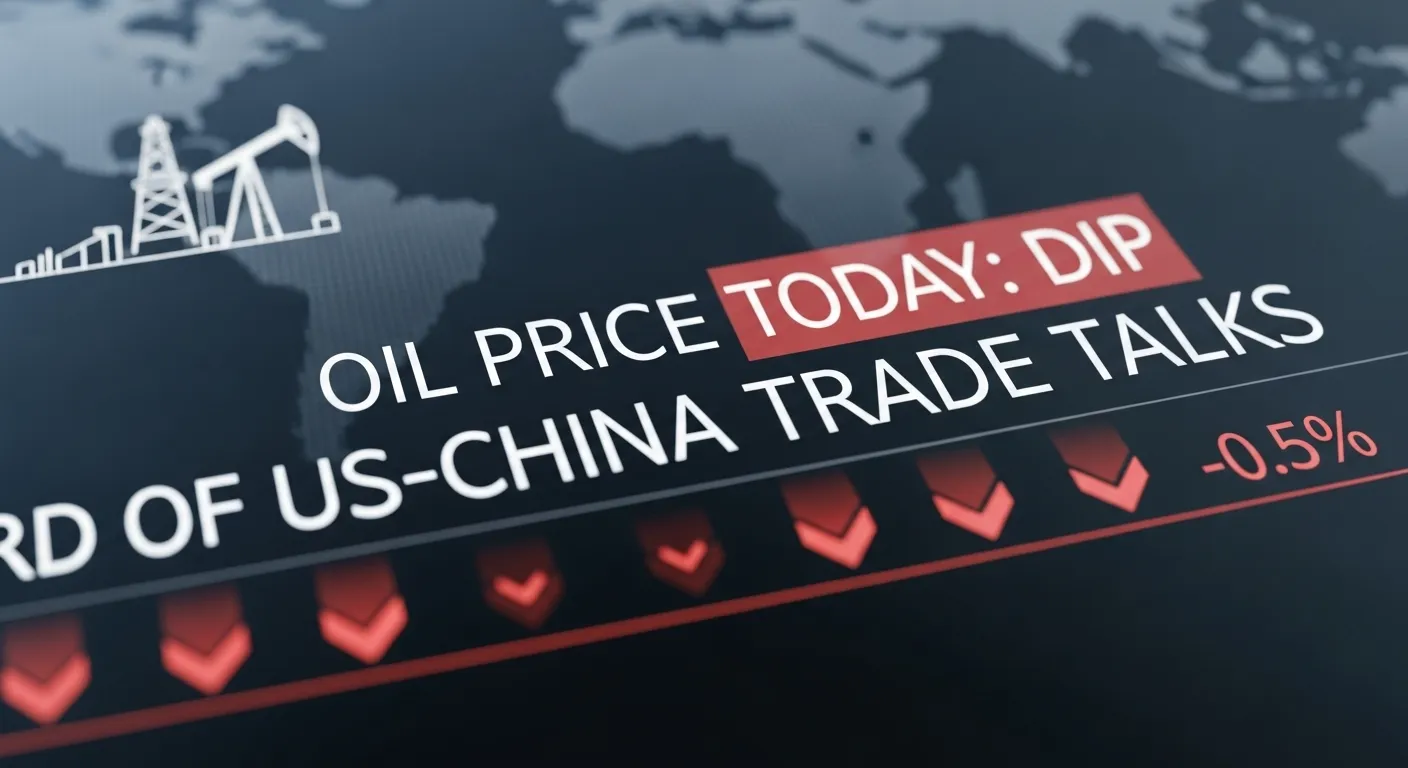Oil Price Today: Prices Dip Slightly Ahead of Crucial US-China Trade Talks
Oil prices have nudged down again today as we await big trade talks between the U.S. and China. The benchmark for “Oil Price Today” is flashing caution: global traders are sitting back and watching. Markets know that when world powers negotiate, the ripple effects hit oil demand, shipping flows, and energy sentiment. Right now we’re seeing a gentle fall, not a crash, but it means things could move quickly if the talks take an unexpected turn.
Current Oil Price Snapshot
As of morning trading, the December contract for Brent crude fell to about $61.06 per barrel, down roughly 0.4 %. Meanwhile, the U.S. benchmark West Texas Intermediate (WTI) slipped toward $57.00 per barrel. Over the past month, crude has dropped around 8.3% in price. Market participants say the mood is one of restraint, not panic, as traders wait for fresh signals on demand and supply.
Why the Dip? Key Drivers
We’re seeing three main forces pushing prices lower:
- Demand concerns: The expected surge in oil consumption hasn’t emerged, especially in large economies. For example, China’s crude storage flow dipped sharply in September.
- Supply worries: Producers are ramping up output, and inventories are rising. The International Energy Agency (IEA) warned of a supply glut into 2026.
- Trade uncertainty: The upcoming U.S.–China trade talks are casting a large shadow. Investors hate ambiguity, and with many still unsure about tariffs, demand forecasts are being pulled back.
So when we put this together, the drop in “Oil Price Today” reflects both too much supply and not enough confidence in demand growth.
Overview of US-China Trade Talks
The trade talks between the United States and China are aimed at easing tariffs and restoring smoother trade flows. Historically, when these two economies clash over trade, it ripples through commodity markets. The last major confrontation created fears of slowing export markets and weaker industrial activity in China, both of which weigh on oil demand.
Now, with the talks on the horizon, traders are trying to estimate: will there be a deal or more friction? If China’s growth slows further, its oil imports may shrink. And if the U.S. imposes new tariffs, global growth could slow. Either scenario weakens demand for oil.
Global Economic Implications
When two big economies like the U.S. and China stumble into trade friction, the consequences spread:
- Demand outlook: Slower growth means less need for fuel, fewer flights, less shipping, all bad for oil.
- Risk sentiment: Investors shift money into safe-haven assets and away from energy-linked bets. That lowers spot demand.
- Currency & trade flows: A stronger U.S. dollar (often tied to trade uncertainty) makes oil more expensive in other currencies, reducing buying power abroad.
Thus, the “Oil Price Today” is being influenced not just by barrels of oil, but by global moods and trade pathways.
Supply-Side Factors
On the supply front, several things are piling up:
- OPEC+ is set to increase production modestly in the coming months; some fear this could add to a supply surplus.
- U.S. shale producers are adding rigs again, which means production may stay high and keep downward pressure on prices.
- China’s crude storage flows dropped sharply in September, which means less build-up in reserves, but also signals weaker import demand.
- Geopolitical risk is still present (Middle East, Russia, Iran), but with a weaker demand backdrop, even disruption fears only provide short-term relief.
All these factors mean supply is not the immediate constraint; demand is. And when supply outpaces demand, prices struggle.
Demand Outlook from Key Economies
Let’s look at the major players:
- China: Industrial output and refinery throughput remain high, but imports are falling. Refiners processed more crude in September than in August, yet storage inflows fell.
- United States: Fuel consumption remains steady, but growth is muted. Also, U.S. inventories rose unexpectedly recently, which is a weak sign.
- Europe: Slower industrial activity and green-policy shifts mean long-term demand is under pressure.
Together, these suggest that demand growth is not the powerhouse it once was. For “Oil Price Today”, weaker expected consumption means softer prices.
Impact on Financial Markets
Oil and financial markets are linked in many ways:
- Energy-sector stocks are feeling pressure as investor sentiment for oil weakens.
- Currencies of major oil-exporting countries may weaken if oil revenues drop, which feeds back into global trade.
- Safe-asset flows (e.g., into U.S. Treasuries) often rise when global trade friction increases, taking money out of riskier assets like commodities.
So when we talk about “Oil Price Today”, we’re also talking about how energy intersects with stocks, currencies, and the broader economy.
What to Watch Next
Here are the key signals we’ll track:
- The start and tone of the upcoming U.S.–China trade talks: do they signal cooperation or escalate tensions?
- Next major data releases: e.g., from the U.S. Energy Information Administration (EIA) on inventories, China’s import and refinery numbers, and global demand forecasts.
- OPEC+ production announcements and rig‐count data from the U.S.
- Central bank signals (especially from the Federal Reserve) and inflation data, because higher rates can dampen economic growth and thus demand for oil.
If these items move in a negative direction for demand, “Oil Price Today” could slip further.
Conclusion
In short, oil prices have dipped, and that dip is meaningful. It reflects cautious demand forecasts, potential oversupply, and trade uncertainty. The upcoming U.S.–China talks are the next big hinge for the market. For now, we remain watchful. If demand shows signs of life, prices may stabilize, but if trade friction deepens, the number to watch could fall below $60 and test $50. The story of “Oil Price Today” is not just about barrels, but about geopolitics, trade, and global growth.
FAQS:
Oil prices are falling because demand is not growing fast. Big countries are using less fuel than expected. At the same time, producers are pumping more oil into the market.
When oil prices drop, energy companies often lose money. Their stock values can go down. But some other businesses benefit, so the overall market impact can be mixed.
China buys large amounts of oil to support factories, transport, and power needs. It also builds big reserves to prepare for future demand or supply problems.
Disclaimer:
This content is for informational purposes only and is not financial advice. Always conduct your research.






